Art, Science, Technology S - U
Numbers are indexed as words (3 = three, 8 = eight)
Scanner Bot: A device used by the Mumian Police to gather digital evidence. Some of its functions include making 3D maps of the terrain and all solids in the vicinity, of the air currents, and of the chemical composition of the area. It can check temperature differentials to see 'shadows' of anything that's been there recently and where they went. For an image of a Scanner Bot click here. (Umbo Job Mum)
Scent Activated Locks: Locks on doors, safes, cabinets, etc. can be unlocked in a variety of ways.
You are probably most familiar with the common metal key. These come in a variety of styles, which is probably why there are many collectors of keys. Combination locks are used on safes and doors--clockwise to 23, counterclockwise to 42, clockwise to..., or you punch in a certain sequence of numbers or letters on a keypad. Sometimes a safe is unlocked electronically at a certain time. Your computer may be "locked" with a password or it is equipped to recognize your finger print. A safe in a "Lovejoy" episode unlocked when it recognized the proper retinal pattern of the user. Bill Nighy got frustrated in "Page Eight" when his key-card wasn't recognized by the lock at MI 5. Perhaps you've suffered the same frustration trying to get into your room at a motel.
The Centaurian Bud Vase, in my novel of the same name, could be used as a "key" in three different ways. You'll have to read the novel when/if it's published to find out how.
A scent activated lock was introduced in the "Ghost Writer in the Sky" chapter of my novel, Silver Threads:
Baroo smiled, turned back to the safe, and exhaled slowly against the chemical sensor of the lock. He turned the handle, pulled the door of the safe open, and retrieved the stack of paper wrapped in the blue ribbon.
Scent activated locks are based on lab-on-a-chip technology. A microchip contains a gas chromatograph, mass spectrometer, dielectric spectrometer, or some similar analytic tool or combination of tools, a microprocessor, memory, and other necessary electronics. Scent activated locks were initially used on safes, but can also be used on homes, businesses, and vehicles.
To train the lock to the desired "combination", the user breathes gently on the chemical sensor region of the lock on the exterior of the door. The contents of the breath are analyzed, classified, and presented to the user on a screen on the inside of the door. Obvious "red herring" readings can be deselected, leaving a mix of chemicals unique to the biochemistry of the user. For instance, if Baroo had taken a drink of Roo'eft wine (as he did in "Ghost Writer in the Sky") before beginning the lock's training, he might want to eliminate the wine's chemistry from the combination. Or, maybe not--Perhaps Baroo wants the lock to recognize him only if he has Roo'eft wine on his breath. Repeating the procedure over several days would allow the program of the lock to recognize the chemicals unique to the user.
Information about the species of the user allows the lock's program to recognize her even as she ages or suffers from some illness.
If desired, the lock could be trained to recognize several users so that members of a family or employees of a business could all open a door or start a vehicle.
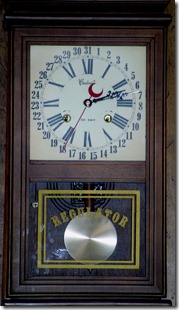 Ship Time: Starships generally adhere to the time units of the cultures that fly them. Earth cultures initially used a 24-hour day. As they left Earth and settled on new planets, they adopted the day length of their new home worlds. Since interstellar travel generally required weeks, starships normally adjusted their day/night cycles to match that of their destination time zone.
Ship Time: Starships generally adhere to the time units of the cultures that fly them. Earth cultures initially used a 24-hour day. As they left Earth and settled on new planets, they adopted the day length of their new home worlds. Since interstellar travel generally required weeks, starships normally adjusted their day/night cycles to match that of their destination time zone.
In this way, they avoided what was once called "jet lag" upon arrival--if it was 9 AM local time when they arrived, the ship’s clock and everyone’s biological clock would agree that it was "9 AM." Since it can’t be 9 AM at all parts of a planet, if there was no fixed destination time zone, then no adjustments to the ship’s clock would be made en route. The clock would remain at the last departure setting.
Snifter: A handheld device used to detect and identify molecules in the air. (Alien Abduction)
Songbird, The: The restored antique Cessna T50 Bobcat of Red Sky in Mourning. (Red Sky in Mourning) This aircraft name was chosen when I first wrote the chapter back in 2004 to be an "Easter Egg," noticeable only to fans of the Sky King TV show popular when I was a kid. I originally described the Songbird as a Beechcraft King Air 350. I have no idea where I got the info that Sky King's Songbird was this model. It is not! Renderosity recently made available for Poser a 3D model of a Beechcraft Model 18. When I checked the Internet to see how closely this plane resembled The Songbird, I was shocked to find that The Songbird was not a Beechcraft of any sort. It was, depending on the broadcast season, a Cessna 50T Bobcat or a Cessna 310B. I've corrected the error in my story.
Space Travel and Teleportation: Space travel can be of three types: Newtonian, Subspace/Hyperspace (Teleportation), and Warp. For more information on this topic, please see the Space Travel and Teleportation page.
Spacecraft: A vehicle capable of travel outside a planetary atmosphere. Although the term includes vehicles capable of interstellar travel (starships) it is commonly used to refer only to vehicles capable of travel within a star system.
 Spex: Spex (plural: spex) are auto-focusing eyeglasses. They can be manufactured as spectacles or as contacts.
Spex: Spex (plural: spex) are auto-focusing eyeglasses. They can be manufactured as spectacles or as contacts.
Spex, in one form or another, were invented independently on a number of different planets. The technology that makes them function depends on where they were produced and has changed over time. Spex are usually made from a type of piezoelectric argon-glass. Electrical currents change the dimensions of the glass, which changes their shape and so changes their focus. Additives to the argon-glass trap incoming light and convert it to electricity. Like the electronics for controlling the focus, the electricity is stored by components in the rims of the glasses.
The direction of gaze of each eye is measured to determine the parallax (i.e., how much the eyes are crossed) so that the focus of the lenses can be adjusted. For contact lenses, the direction of gaze is determined by measuring the tension of the muscles controlling the positions of each eye. Some individuals and some species prefer or require spectacles. In that case, the direction of gaze is found from reflections from the surface of the cornea (or its equivalent, dependent on the planetary species).
Although the need for eyeglasses decreased as corrective medical procedures improved, some individuals continue to prefer to wear contacts or spectacles. Spectacles, in particular, are worn as a dictate of local fashion.
Other names by which Spex are known include i-focals (shortened from infinite-focals) and eye-focals.
Standby-shields: When a starship is unattended or "parked," it's shields can be left in a low-energy use mode which automatically switches to full strength to deflect things with high energy (laser beams, missiles, etc.) Slow moving things (crew or air) can come and go. They will feel only a slight retarding force. (The Galaxy's Guide to the Hitchhiker)
Starship: A spacecraft capable of interstellar travel.
Starship fuel: As starships move through space they collect interstellar gas (mostly hydrogen) via laser ramscoops. The collected hydrogen is fused as needed to helium via a catalytic cold-fusion process utilizing a sort of stellar carbon-nitrogen-oxygen cycle. The energy released can be transduced into impulse thrust of the ship's rocket engines, energy needed for subspace or warp travel, and other forms of energy required by the starship.
StopFlo: A first-aid preparation which stops bleeding from wounds. (Jake and the Frat Man)
Subspace beacon: Device for sending a signal through subspace to allow one to track its location. (Someday My Prints Will Come)
Subspace net: Technology which allows a specified object (and the air surrounding it) to be transported via subspace. The subspace net is normally used to capture criminals whose location may not be well defined because they are moving. The planetary race of the subject may be specified so that just the individual(s) desired can be captured. The individual's clothing--and weapons--will be left behind. The only drawback to this technology is that, to avoid the expense of two-way transport (replacing the volume of air captured along with the subject), a vacuum is left behind, producing an explosive thunderclap.
Subspace Power Receiver or Transmitter: Technology developed by Claudius Electronics which allows energy to be transmitted through subspace from a central source to its destination. (6 June 2403)
TakeMe: An autopilot type of technology installed in a vehicle or other craft. When programmed manually or after having a route uploaded, TakeMe will drive or pilot a vehicle or other craft to the desired destination. (Royal Glass)
Tartian Egg: An egg-shaped collectible made from a large diamond carved into eggs within eggs (something like terrestrial ivory Chinese Puzzle Boxes), each encrusted with rare metals and jewels. Fabulously expensive. The largest diamonds are roughly the size of the human head. Nobody knows their source - Is "Tars" a star, planet, geographic location, culture, the craftsperson? Because they are so rare, few have ever been seen and many consider them to be mythological. (In the Hole of the Mountain King, The Tartian Egg, and The Pirates of Panjandrum)
Telabortion: An abortion performed using a small two-way subspace net so that the no invasive procedure is required. The fetus is removed and replaced by a polypeptide scaffolding. Blood vessels temporarily infiltrate the scaffolding, but the entire structure is soon absorbed back into the body.
Teleportal: Any device which allows transportation via subspace (teleportation) from one location to another by moving an object through an opening. (See also: Purse portal, Televator). For more information on teleportation by electronic or biological means see the Space Travel and Teleportation page.
The teleportal is an application of subspace travel which was introduced by the Taupoians.
Computers using successive approximation techniques can make the calculations required for moving matter short space-time distances so that we can teleport matter from one location to another.
Teleportation often involves the movement of the contents of one volume of space to another. Early televators and loose teleportation nets (both to be discussed in later posts) are examples of this technology.
The Taupoians developed teleportal technology in which an object was scanned as it moved through an aperture and teleported layer by layer to a destination aperture. The original technology was used in what were known as "purse portals." The destination teleportal and communication technologies were built into purses (or something equivalent) as shopping devices. The user spoke into the portal to request some consumer item--clothes or food, for example. She could then retrieve the requested object from her purse. Because the origin could be fixed, most of the necessary calculations were simplified and could be done in advance. Calculations to get the object to its destination were normally accurate enough that the original and destination objects were practically indistinguishable.
"Practically indistinguishable" meant that living things could not be sent through a purse portal without the danger of some undesirable changes. However, if the origin and terminus teleportals were at fixed locations, calculations could be very precise and done in advance so that even living things could safely walk right through a sufficiently large teleportal (the televator.)
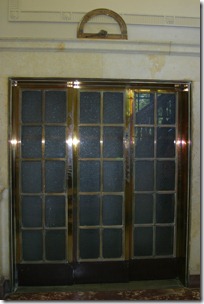 Televator: A door-like teleportal which allows transportation via subspace (teleportation) from one location to another. Televators are most often used for travel from floor to floor within a building, or from building to building in a complex of buildings. For more information on teleportation by electronic or biological means see the Space Travel and Teleportation page.
Televator: A door-like teleportal which allows transportation via subspace (teleportation) from one location to another. Televators are most often used for travel from floor to floor within a building, or from building to building in a complex of buildings. For more information on teleportation by electronic or biological means see the Space Travel and Teleportation page.
The televator is one application of the teleportal.
Computers using successive approximation techniques can make the calculations required for moving matter short space-time distances through subspace so that we can teleport matter from one location to another. When the start and destination points are fixed, most of the calculations can be done in advance and the teleportation is virtually instantaneous.
Televators are most often used for travel from floor to floor within a building, or from building to building in a complex of buildings.
The first televators looked and operated much like ordinary elevators--the user pressed a button to open the door and stepped into a box-like enclosure. The door closed while the user chose his destination. In a moment, the door reopened and the user stepped out at that location. With this technology, the entire contents of the televator chamber were exchanged with the contents of the terminus chamber.
Current televators are more economical because they make use of teleportals. The apertures of a televator system are normally covered by closed doors. The user approaches the entrance door, selects her destination from a control panel at the side of the door, and the door opens. The opening of the door activates the apertures, opens the exit door, and the user walks through. She appears to remain one continuous object--even if she backs up or turns during transition. The computer automatically keeps the teleportal active until both apertures are clear so that even large items can be brought through.
A power failure or surge could potentially leave part of a user at the start and another part at the terminus. Televator systems are equipped with their own power systems and every use is logged. Logs are monitored regularly in order to detect and correct any anomalies in the operation of the televator. Most televator companies have flawless safety records.
For more information on teleportation by electronic or biological means see the Space Travel and Teleportation page.
Texy: A slang word for a text message. (Alien Abduction)Thixotropic lock: Most familiar fluids, like water, oil or gasoline, have a viscosity (resistance to flow) which is unique to the substance and dependent only on temperature. Oils, for example, have a much higher viscosity than water. A cold fluid (molasses in January) will have a higher viscosity than the same fluid when warm, and vise versa. Such fluids are known as Newtonian fluids.
Some fluids are non-Newtonian fluids. Their viscosity changes when they are subject to some sort of stress--such as shaking or stirring. Catsup is a non-Newtonian fluid, which is probably why it goes "ploop" and you get more than you really wanted on your burger when you bang the end of the bottle.
I discussed two types of non-Newtonian fluids in the Argon-Glass Fabric entry. Dilatant fluids increase their viscosity dependent on the rate of stress--they go from fluid to gel quickly if they are stressed suddenly. Rheopectic fluids increase their viscosity dependent on the amount of stress--greater stress produces greater viscosity. You may have seen the NOVA ad on PBS where the barefoot guy runs across a pool containing a mixture of corn starch and water. (If you wondered what that was all about, now you know.)
The thixotropic fluid is another type of non-Newtonian fluid. In this case, the viscosity decreases when the fluid is agitated or a stress is applied to provide pressure. Catsup is a thixotropic fluid. So is the synovial fluid found between bones in some joints. Another example is the ink in the Fisher Space Pen, which goes from gel to liquid as the pen's ball rotates against it.
A thixotropic lock appears in the "Grimace" chapter of my novel in progress, "The Centaurian Bud Vase." This lock resembles a combination lock in that it does not require a traditional key. Like a combination lock, it has a knob or disk which must be turned to drive the internal works of the lock. The internal mechanism resembles the automatic transmission in an automobile. In a thixotropic lock, torque on a fluid turns the unlocking mechanism. However, unless the external knob or disk is turned with the proper pressure, the viscosity of the fluid inside will be too great or too small and the internal mechanism will not provide the proper torque to open the lock.
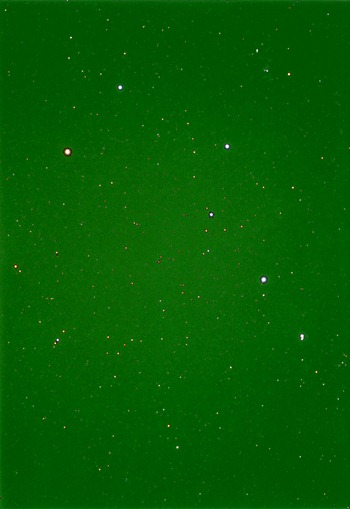 3-Kelvins band: The ability of a starship to display the background radiation of the universe so that any object in space which absorbs or reflects this radiation can be seen. (Golden Needles)
3-Kelvins band: The ability of a starship to display the background radiation of the universe so that any object in space which absorbs or reflects this radiation can be seen. (Golden Needles)
Because space normally looks black, some starships are painted "Space Black" in an effort to conceal them. Of course, they still block out stars behind them and so are not invisible, but their presence is not as obvious as a metallic or some colored surface would make them.
One technological method to fight this type of hiding was the development of scanners that converted the 3 Kelvin background radiation of the universe, the afterglow of the Big Bang, into visible light. Displaying the "3-kelvins band" radiation in a false color on a navicom screen or other viewscreen allows space black ships to be readily seen.
The ships of the defense fleet of the raptors' planet, Home, displayed the 3-kelvins band in green in the "Golden Needles" chapter of my novel, Silver Threads.
Toyota Camaro: Automobile model produced after the merger of Toyota and General Motors. (Alien Abduction)
Tractor beam: A field generated by a field collimator which attracts a targeted object. They could be used to load cargo, but are more often mentioned as a means of preventing the escape of a starship. (Monkey Trap)
Tramontana: Spanish sports car. Generally custom made. Sara Leone's "Red Flash" was an amphibian with rear propellers. (Shuttle 54, Where R U?)
Treeshooter: (Are We Alone?) During the 300 years between their discovery of the warp drive and The Great Dying, the Taupoians sent out a number of interstellar expeditions to "taupiform" suitable planets for future colonization.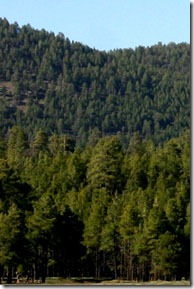 The treeshooter was one of the devices developed for these projects.
The treeshooter was one of the devices developed for these projects.
The typical treeshooter is an ellipsoid 20 feet long, 10 feet wide and 5 feet thick at the center. A 3-foot wide transparent canopy covers the single-seat pilot's cockpit in the nose of the craft. The treeshooter rests on retractable tricycle landing pads.
When fully charged before take-off, the tree shooter has a range of about 10 hours, a maximum speed of 100 miles per hour, and can attain an altitude of 1500 feet. However, these are used only for travel to or from targets. The operating altitude for the treeshooter is 6 feet at a speed of 10 to 20 miles per hour, depending on the terrain.
Guided by the treeshooter's GPS system, the pilot flies the treeshooter over a predetermined path. The craft's "gun" is located at the center of the underside and is fed a polyamide ribbon of tree spikes which are fired into the ground every 10 feet by bursts of compressed air. The suitability of the soil for treeshooting and the force used to fire the spikes are determined by ground-penetrating radar.
Tree spikes are 2-inch saplings encased with the seeds of ground cover and a mixture of microbial soil flora and fauna in molded polyamide. Each spike is a half inch in diameter and 3 inches in length. Once impaled in the soil, the polyamide is dissolved by moisture and the action of the enclosed microbes.
Tree spikes can be used to plant monocultures, but normally consist of mixtures of trees appropriate to the climate of the region being planted.
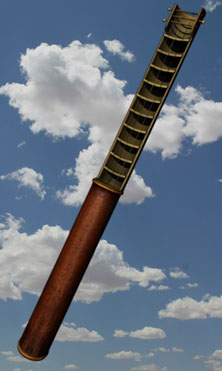 Tri-string: (Split Personality) The Tri-string is a
native musical instrument from Waxon. It consists of a
neck, similar to a banjo or guitar, with three strings
that extend down into a resonating tube.
Tri-string: (Split Personality) The Tri-string is a
native musical instrument from Waxon. It consists of a
neck, similar to a banjo or guitar, with three strings
that extend down into a resonating tube.
One of the strings is the melody string. The other two are
the drone strings. These can be played in a variety of
ways, but resemble the techniques used for the Appalachian,
or mountain, dulcimer. Most commonly, the melody string
is fretted with a short piece of bamboo (the "noter") and
the drone strings are simply strummed (or played with a
bow) at the same time as the melody string. How the
tri-string is played depends on the artist and the style
of the
tri-string itself.
Tri-strings come in a variety of styles. The major differences are the length and diameter of the "tosh" (the resonating tube), the length of the neck, and the pattern of the frets.
The traditional tri-string is about two feet long
(remember, Waxonians are only about three feet tall),
half of which is the tosh, which is about two inches
inside diameter (with a wall thickness of about an eighth of an inch.)
Tri-strings like this usually have a shoulder strap attached to each end of the instrument.
The traditional tri-string style is usually slung over the musician's shoulder like a guitar, strummed with the left hand and fretted with the right (or the opposite for a left handed musician.)
Longer tri-strings have a peg at the bottom so that they can be rested on the ground (like a bass violin.)
The tosh is traditionally made from a length of Waxonian bamboo and polished to a high gloss. The neck and bottom peg (if present) may be extensions of the same piece of bamboo or they may be constructed of some other material and fastened to the tosh. When the neck is of bamboo, the frets are made so that their tops are flat and the backs are curved to fit the bamboo.
Three tuning pegs are located at the top end of the neck.
The noter is often made of a smaller diameter piece of bamboo, of a size to fit the musician's fretting finger.
Musicians sometimes do scrimshaw work on the tosh and back of the neck, decorating them with pictures or artistic designs.
3D Model of a tri-string(below): Use your mouse to rotate the model up/down or left/right in Firefox or some other modern browser. It may not work with Internet Explorer version 10 or earlier.
Tuned Neutron Laser: see Neutron Laser
Ultrasony: A dishwasher that uses ultrasound to convert uneaten bits of food into dust and then suctions it away. (Shuttle 54, Where R U?)
Page updated: 9 October 2020
Page created: 19 January 2012